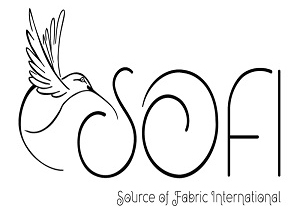A Complete Guide to Textured Fabric Understanding
In the fields of textile art, fashion, and interior design, textured materials are now considered essential. Their distinctive surfaces are a favorite among designers and do-it-yourselfers because they can give any project depth, interest, and tactile quality. We’ll look at what textured textiles are, how to deal with them, what kinds are out there, and some applications for them in this post.
How do Textured Fabrics Work?
Textured fabrics are textiles with a unique surface quality that can be produced using a variety of methods. Textured materials can be raised, patterned, or uneven, offering both tactile and visual stimulation, in contrast to smooth fabrics. This texture can be produced by post-production treatments or in the manufacturing process.
Types of Fabrics with Textures
There are many different kinds of textured fabrics, and each has special qualities and applications.
Silk
Velvet is an opulent material distinguished by its smooth, velvety texture. It is made of synthetic, cotton, or silk fibers and has a deep pile that adds depth. Velvet is often used in formal attire, furniture, and home decor, bringing a sophisticated touch to any scene.
Tweed
The traditional cloth tweed is renowned for its elaborate patterns and coarse feel. Traditionally fashioned from wool, it is robust and warm, making it perfect for outerwear and tailored items. The texture of tweed adds visual appeal, generally with a speckled appearance that reflects different colors.
Corduroy
Corduroy is distinguished by its unique ridges or “wales.” There are many different kinds of textured fabrics, and each has special qualities and applications.
The brocade
Rich brocade is frequently used for household textiles and formal wear. It is typically made of silk or synthetic fibers and has raised designs. A favored material for evening gowns and ornamental pillows, brocade has an opulent quality because of its complex patterns and textures.
Chenille
Because tiny yarn strands are woven into the fabric, chenille is renowned for having a soft, fuzzy texture. Because of its warm feel, it is frequently used in children’s apparel, blankets, and upholstery. The texture of chenille can give any design a fun touch.
Textured Textiles
Uneven textures give fabrics like slub and boucle a distinctive visual impact. The looped yarns of the boucle lend an air of refinement, while the differences in the thickness of slub textiles impart a more relaxed mood. Both kinds are well-liked in modern textiles and clothing.
Ribbon
Open threads and elaborate patterns give lace its distinct feel, despite the fact that it is frequently connected with delicacy. In clothes, table linens, and décor, lace can be used as an overlay, an accent piece, or a stand-alone fabric. A striking visual impression is produced by the contrast between the detailed texture and the smooth surrounding surfaces.
Uses for Textured Textiles
Textured fabrics are used in many different contexts, such as comfortable home interiors and high-fashion runways. Here are a few typical applications:
Style
Textured fabrics are used in the fashion industry to give clothing depth and appeal. To improve the overall appearance, designers frequently combine these textiles into accessories, casual wear, and evening dresses. An item of clothing may feel more opulent and visually appealing due to its tactile texture.
Interior Design
Textured textiles are essential to home design. These textiles may give a space warmth and personality, whether they are used for bedding, upholstery, or curtains and cushions. A dynamic area can be created by combining various textures, which will make it feel more trendy and welcoming.
Printed Textile Art
Textured textiles offer a limitless creative canvas for textile artists. In order to create original works using texture as a primary theme, artists frequently experiment with different mediums and methods. Textured textiles can be used to creatively bring art to life, whether through weaving, quilting, or needlework.
upholstered
Because of their strength and visual appeal, textured textiles are a popular option for upholstery. They can make conventional furniture more comfortable and stylish, turning them into focal points. Particularly popular fabrics for couches and chairs are velvet, tweed, and chenille.
Utilizing Textured Textiles
There are a few things to think about when handling textured fabrics:
Select the Appropriate Fabric
Choose a textured cloth that fits the specifications of your project. Take into account the fabric’s weight, drape, and upkeep requirements. While some textures are more forgiving, others can need more attention.
Employ the Right Tools
Use the proper tools while sewing with textured materials. Sharp needles are necessary to prevent snagging, and a walking foot can aid prevent slippage. Verify if your sewing machine can handle pile or thicker materials, as they can need for different settings.
Take Into Account Layering
Layers of textured textiles can look great. Mix and match several textures to get a visually captivating effect. For example, utilize several textured fabrics in a single design for added interest, or pair a smooth and textured fabric to create contrast.
Confirm Before Investing
Make swatches or samples before embarking on a project. On these samples, experiment with various stitching methods, finishes, and decorations to observe how they affect the texture.
Upkeep Concerns
Different textured textiles demand different levels of upkeep. While some can be machine washed, some might need to be dry cleaned. Maintaining the quality and appearance of the fabric requires that you always read care labels and adhere to suggested practices.
Conclusion
In the realm of textiles, textured fabrics are a fascinating addition that provides countless opportunities for creativity and design. Their distinctive surfaces may elevate clothes, improve interiors, and stimulate artistic expression. Anyone can add this dynamic aspect to their projects and give their creations depth and personality by learning about the different types of textured fabrics and how to work with them. Discovering the world of textured fabrics can result in creative ideas and enjoyable discoveries, regardless of experience level in design.


